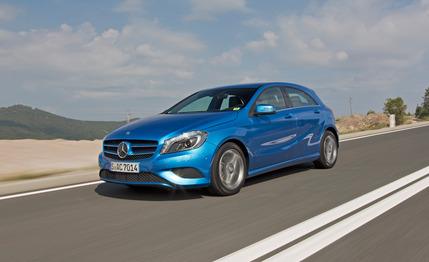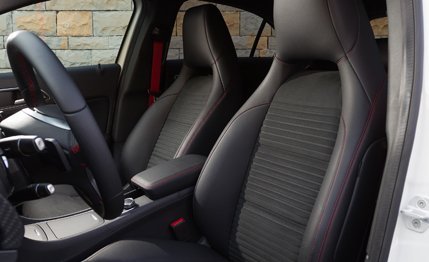
 First Drive Review
First Drive Review
Fifteen years ago, Mercedes-Benz saw room below its traditional portfolio of rear-wheel-drive sedans for something different. A car tall but short of length, with power routed through the front wheels, provisions for alternative powertrains, and styling that wouldn’t tick the usual Benz boxes but instead would be funky and contemporary. The A-class was the result.
Audi had a different idea. It would take a corporate front-wheel-drive platform, dress it up with familial and sleek styling, pack in a ton of gadgets, and sell it at a premium price. That car was, of course, the A3.
The four-ringers’ idea was the better, much-copied one, and Mercedes-Benz has implicitly conceded defeat with its new, third-generation A-class. Mercedes’ CC (“Compact Car”) architecture, which forms the basis of the A-class and will be shared with Infiniti, is decidedly conventional. Unlike with the innovative sandwich-floored first-gen A, there is no room to accommodate, say, a battery pack for hybrid or fully electric versions. (The latest Audi A3 will definitely offer a plug-in hybrid, and an electric model is still on the table.) Only the closely related B-class, which is taller and intended to be a people mover, can swallow a sizable battery pack, which will compromise interior space.
Abandoning the previous model’s philosophy means the 2013 A-class isn’t the most spacious thing going. But there is plenty of room up front, even as it took us some experimenting to find a comfortable seating position. Neither the rear seats nor the trunk is particularly cavernous, but both will be large enough for most excursions or shopping trips.


Naturally, Many Engines—in Europe
The all-four-cylinder A-class model lineup starts with the A180, which is available with diesel and gas-fired engines. Actually, the A180 offers a choice of two diesels, although it’s not much of a choice. If you order a six-speed manual, you get the OM607, a 1.5-liter modified Renault unit with 107 hp and 184 lb-ft of torque—more on the Renault/Daimler tie-up here—and seven-speed dual-clutch models get a 1.8-liter Mercedes OM651 mill with the same output. We didn’t get to drive either of them. The gas-fired A180 uses a 1.6-liter four boasting 121 hp.
The A200 likewise is available in diesel and petrol flavors. The latter has a 154-hp version of the 1.6-liter four. The A200 CDI uses a 134-hp, 1.8-liter OM651 that’s smooth and flexible, delivering its 221 lb-ft from 1600 to 3000 rpm. It stormed up mountain roads with ease, rarely requiring a downshift below third gear. Only when you start to crest 100 mph does this midrange diesel lose steam. For European customers who plan to explore triple-digit territory with regularity, the A220 CDI and its 168-hp, 2.1-liter producing 258 lb-ft of torque is the better choice. This long-stroke variation of the OM651 is less polished and noisier than the 1.8, but those sins are sacrifices gladly made for the extra grunt. And even more twist is around the corner. A twin-turbo 2.1 diesel with roughly 200 hp and torque well over 300 lb-ft is a likely addition to the lineup; this engine is the one that will make it to U.S.-market Mercedes. It’s rated for 190 hp and 369 lb-ft in the GLK250 BlueTec that’s due here early next year.
But twist isn’t the sole province of the A-class’s diesel engines: 258 lb-ft come courtesy of the gasoline-drinking 208-hp, 2.0-liter turbocharged four in the A250. It’s this engine we’ll see in the A-class derivatives headed our way, which include the swoopy CLA-class compact sedan, a crossover likely to be called the GLA, and potentially others. (The CLA will take on the Audi A3 sedan, and the GLA will challenge the BMW X1 and the Audi Q3.) With our estimated 0-to-60-mph time of 6.5 seconds and a governed top speed of 150 mph, the A250 is decidedly high-po among its competitive set. But this is no wild bronco; the A250 piles on speed effortlessly and with cold precision. (Our spec panel and performance estimates cover only those engines we believe are most likely to make it to U.S.-market vehicles.)